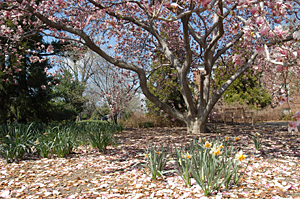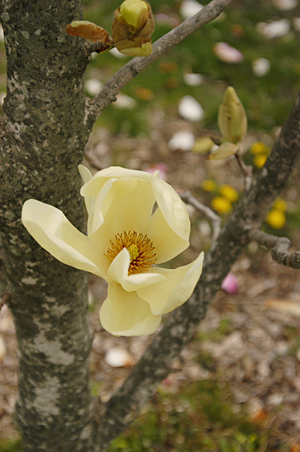
ADVERTISEMENT
- Rozovsky wins prestigious NSF Early Career Award
- UD students meet alumni, experience 'closing bell' at NYSE
- Newark Police seek assistance in identifying suspects in robbery
- Rivlin says bipartisan budget action, stronger budget rules key to reversing debt
- Stink bugs shouldn't pose problem until late summer
- Gao to honor Placido Domingo in Washington performance
- Adopt-A-Highway project keeps Lewes road clean
- WVUD's Radiothon fundraiser runs April 1-10
- W.D. Snodgrass Symposium to honor Pulitzer winner
- New guide helps cancer patients manage symptoms
- UD in the News, March 25, 2011
- For the Record, March 25, 2011
- Public opinion expert discusses world views of U.S. in Global Agenda series
- Congressional delegation, dean laud Center for Community Research and Service program
- Center for Political Communication sets symposium on politics, entertainment
- Students work to raise funds, awareness of domestic violence
- Equestrian team wins regional championship in Western riding
- Markell, Harker stress importance of agriculture to Delaware's economy
- Carol A. Ammon MBA Case Competition winners announced
- Prof presents blood-clotting studies at Gordon Research Conference
- Sexual Assault Awareness Month events, programs announced
- Stay connected with Sea Grant, CEOE e-newsletter
- A message to UD regarding the tragedy in Japan
- More News >>
- March 31-May 14: REP stages Neil Simon's 'The Good Doctor'
- April 2: Newark plans annual 'wine and dine'
- April 5: Expert perspective on U.S. health care
- April 5: Comedian Ace Guillen to visit Scrounge
- April 6, May 4: School of Nursing sponsors research lecture series
- April 6-May 4: Confucius Institute presents Chinese Film Series on Wednesdays
- April 6: IPCC's Pachauri to discuss sustainable development in DENIN Dialogue Series
- April 7: 'WVUDstock' radiothon concert announced
- April 8: English Language Institute presents 'Arts in Translation'
- April 9: Green and Healthy Living Expo planned at The Bob
- April 9: Center for Political Communication to host Onion editor
- April 10: Alumni Easter Egg-stravaganza planned
- April 11: CDS session to focus on visual assistive technologies
- April 12: T.J. Stiles to speak at UDLA annual dinner
- April 15, 16: Annual UD push lawnmower tune-up scheduled
- April 15, 16: Master Players series presents iMusic 4, China Magpie
- April 15, 16: Delaware Symphony, UD chorus to perform Mahler work
- April 18: Former NFL Coach Bill Cowher featured in UD Speaks
- April 21-24: Sesame Street Live brings Elmo and friends to The Bob
- April 30: Save the date for Ag Day 2011 at UD
- April 30: Symposium to consider 'Frontiers at the Chemistry-Biology Interface'
- April 30-May 1: Relay for Life set at Delaware Field House
- May 4: Delaware Membrane Protein Symposium announced
- May 5: Northwestern University's Leon Keer to deliver Kerr lecture
- May 7: Women's volleyball team to host second annual Spring Fling
- Through May 3: SPPA announces speakers for 10th annual lecture series
- Through May 4: Global Agenda sees U.S. through others' eyes; World Bank president to speak
- Through May 4: 'Research on Race, Ethnicity, Culture' topic of series
- Through May 9: Black American Studies announces lecture series
- Through May 11: 'Challenges in Jewish Culture' lecture series announced
- Through May 11: Area Studies research featured in speaker series
- Through June 5: 'Andy Warhol: Behind the Camera' on view in Old College Gallery
- Through July 15: 'Bodyscapes' on view at Mechanical Hall Gallery
- More What's Happening >>
- UD calendar >>
- Middle States evaluation team on campus April 5
- Phipps named HR Liaison of the Quarter
- Senior wins iPad for participating in assessment study
- April 19: Procurement Services schedules information sessions
- UD Bookstore announces spring break hours
- HealthyU Wellness Program encourages employees to 'Step into Spring'
- April 8-29: Faculty roundtable series considers student engagement
- GRE is changing; learn more at April 15 info session
- April 30: UD Evening with Blue Rocks set for employees
- Morris Library to be open 24/7 during final exams
- More Campus FYI >>
12:48 p.m., March 22, 2011----When John Frett leads a guided walk of the University of Delaware Botanic Gardens on March 31, he's hoping to point out a few early blooming magnolias. More likely, though, he'll head to the greenhouse to show off magnolias in flower.
Non-native magnolias typically start blooming in Delaware in April while the native varieties wait until May.
With plenty of other March blooms to enjoy -- winterhazel, forsythia, hellebores and some dogwoods -- why the rush to spot magnolias?
The walk is a spring tradition that highlights plants available at the UD Botanic Gardens Plant Sale. Along with winterhazel, magnolias will be a featured plant of this year's sale, which is open to the public April 29-30.
Almost everyone loves magnolias. Frett, the director of the UD Botanic Gardens, is no exception. However, he's reluctant to single out a best-loved cultivar or species. “It's like picking a favorite child, they're all fabulous,” says Frett.
Magnolias vary widely. The 80 or so recognized species include trees and shrubs; deciduous plants and evergreens; cold-hardy varieties that do well in Maine and others that flourish in the tropics. About the only thing they have in common are the distinctive, tulip-shaped flowers. And most -- but not all -- are highly fragrant.
Under Frett's leadership, the magnolia collection at the UD Botanic Gardens has been expanded to 100 taxa of magnolia, with some 125 magnolias in all.
“The UDBG's fantastic collection of magnolias includes a nice variety of native and non-native species and cultivars,” says Sue Barton, Cooperative Extension's ornamental horticulture specialist.
Magnolias are widely scattered throughout the UD gardens but large groupings can be found between Townsend and Worrilow Halls, south of Townsend, and also north of UD's outdoor pool.
In assembling the collection, Frett looked for a progression of flowering, from the earliest species, in April, to varieties that are still going strong in June. He also included rich and unusual colors, found in the hybrid varieties. In addition to characteristic pink or white petals, magnolia blooms can be light to medium purple, deep purple that is almost red, and yellow.
Barton has one of the yellow varieties in her backyard. “I bought the 'Elizabeth' cultivar from the UDBG sale a number of years ago because my older daughter is named Elizabeth,” she explains. “This tree will be covered with yellow flowers in about a month.”
Despite its name, “Elizabeth” isn't Barton's favorite backyard magnolia. That distinction goes to the native sweetbay magnolias growing near her patio. “They're multi-stemmed so they help enclose the patio but you can still view through them so they don't make it claustrophobic,” she says.
Carrie Murphy, the Extension horticulture agent for New Castle County, says the sweetbay is the top pick for most Delaware gardeners. “Including me,” she adds.
“The sweetbay magnolia is by far one of my favorite plants -- it has beautiful late spring and early summer blooms and is lightly fragrant.”
But what Murphy really likes about the sweetbay isn't apparent at first glance. “I love the underside of the foliage -- when the wind blows and rustles the leaves, the silver underside of the leaves becomes visible and it's absolutely gorgeous,” she says.
Several sweetbays have been added to the Master Garden Demonstration garden at the county Extension office in Newark. At the demo garden, home gardeners often ask for recommendations for small flowering trees and sweetbay nicely fits the bill. It prefers moist soil and some shade and even works well in wet sites. But it's also adaptable to drier conditions, says Murphy.
Three cultivars of sweetbay will be available at the plant sale: “Mardi Gras,” with a butter-yellow variegated leaf; “Perry Paige,” a new dwarf variety only five to eight feet tall; and “Green Shadow,” a selection that Frett describes as “nearly an evergreen.”
Two other native magnolias will be sold, Magnolia macrophylla “Big Leaf Magnolia,” featuring huge leaves with a tropical feel and Magnolia pyramidata “Pyramid Magnolia,” which is considered rare. Also available will be three hybrids from native species, including two that originated from a cross with the native cucumber tree.
Guided walk
March 31: An hour-and-a-half walk through the UD Botanic Gardens, focusing on plant sale selections. 4 p.m. $5. Call 302-831-2531 or email [kelsch@udel.edu] to register. Maximum 35 people.
UDBG plant sale
Public sale hours are 3-7 p.m., April 29; 9:30 a.m. to 4 p.m., April 30. For more information, call 302-831-2531 or go to the UDBG website.
Article by Margo McDonough
Photos by Danielle Quigley



